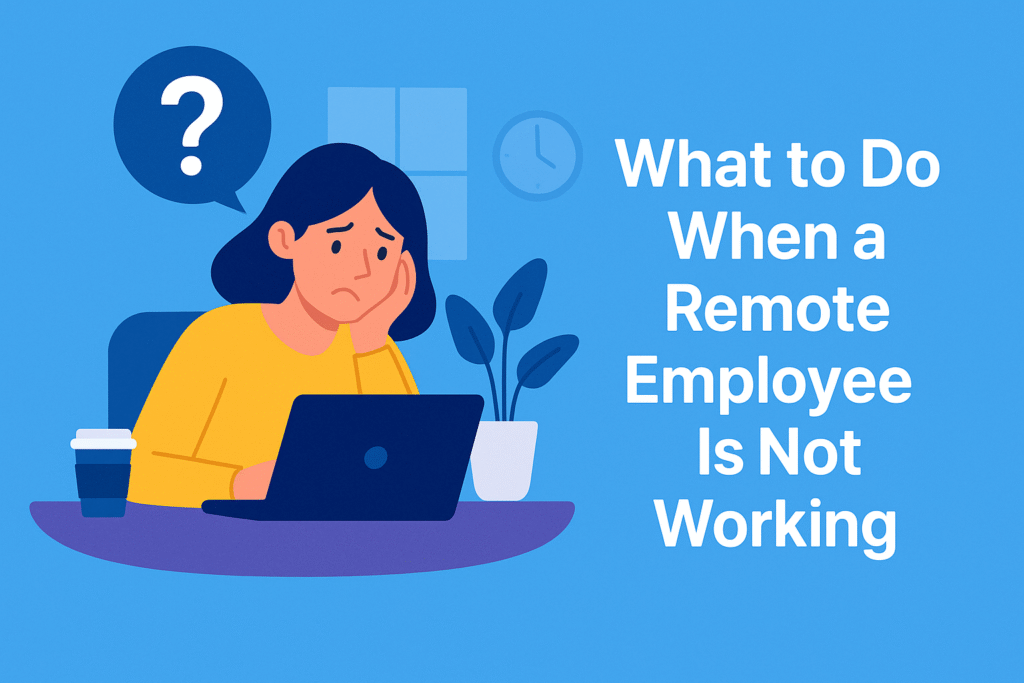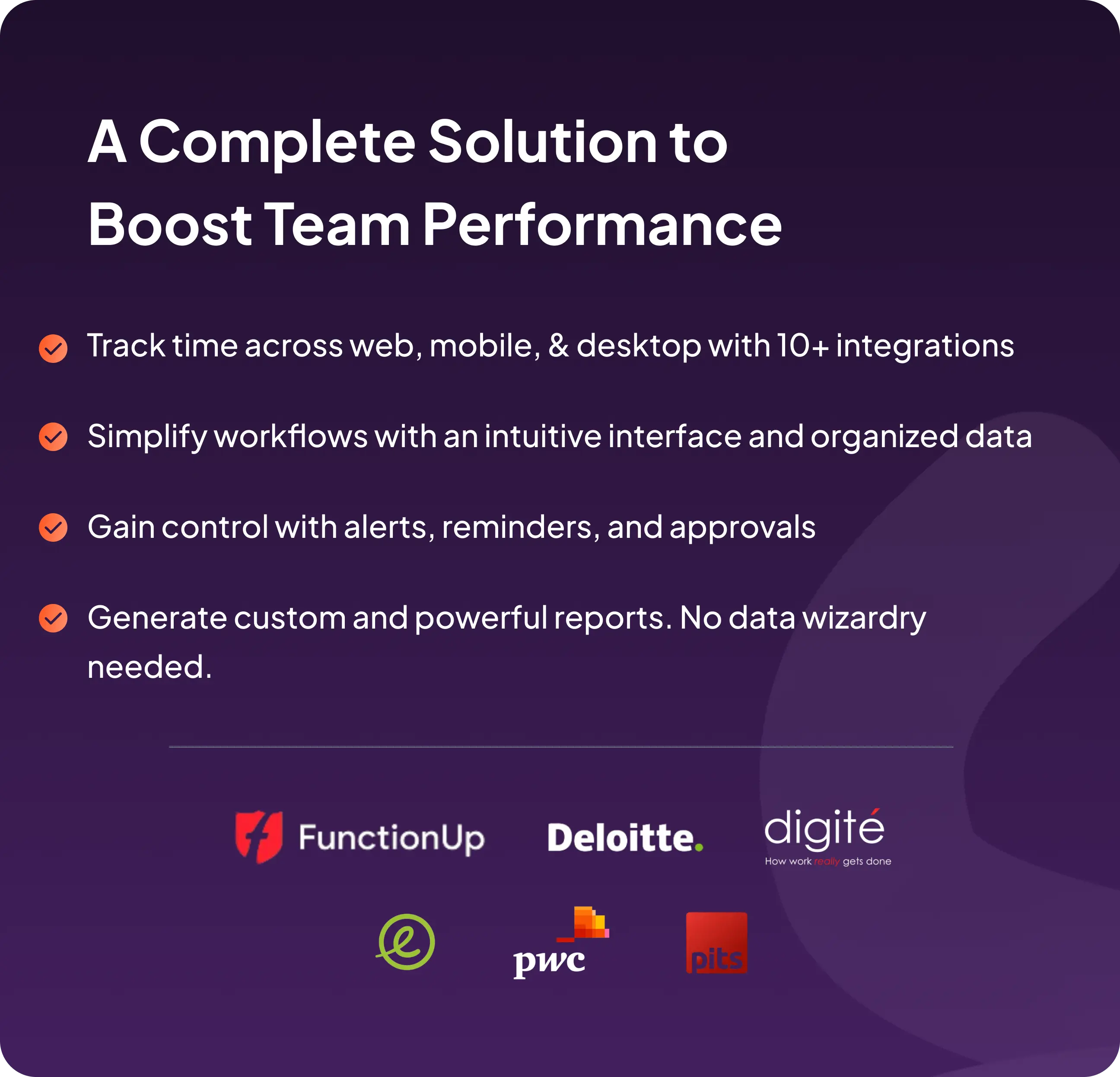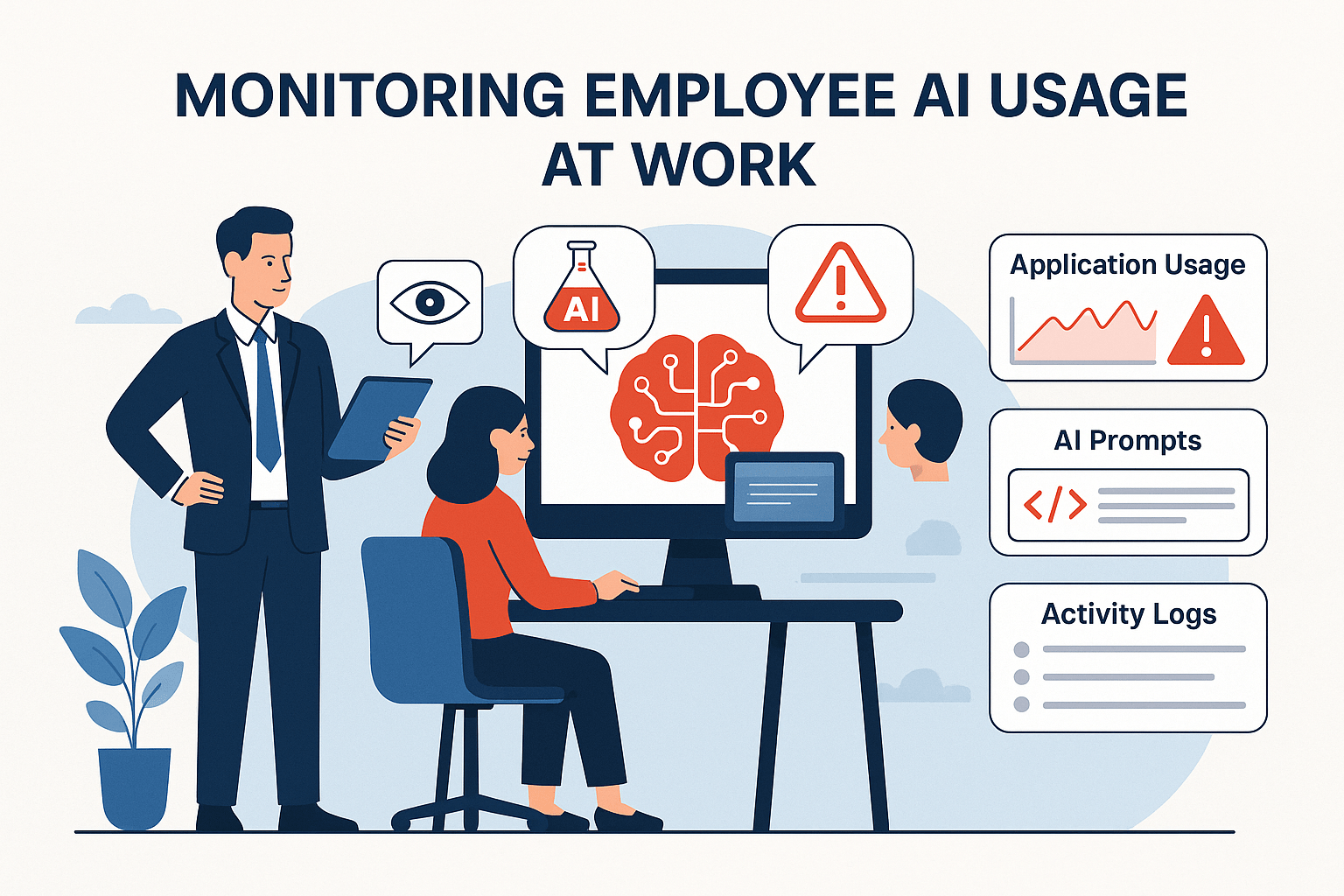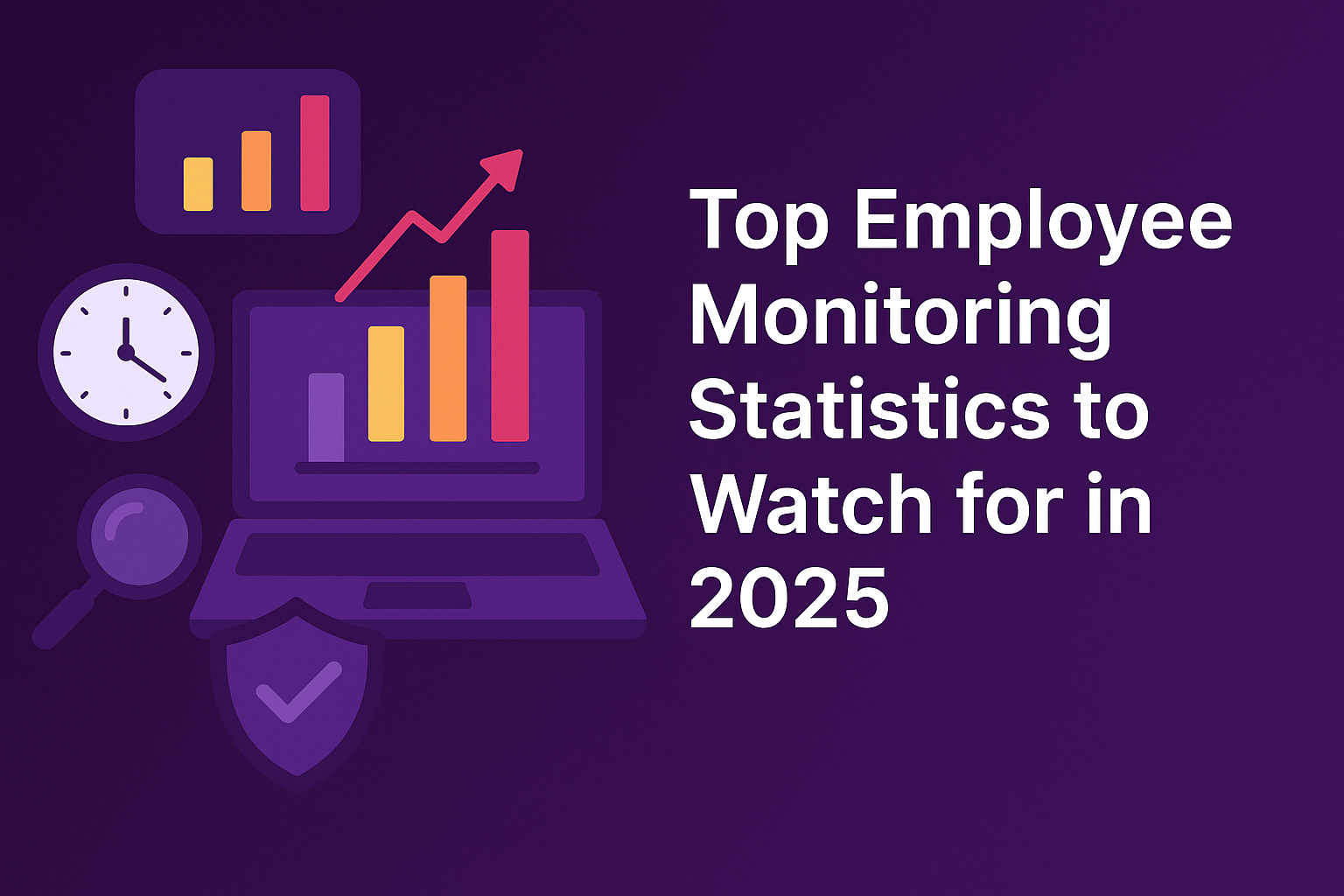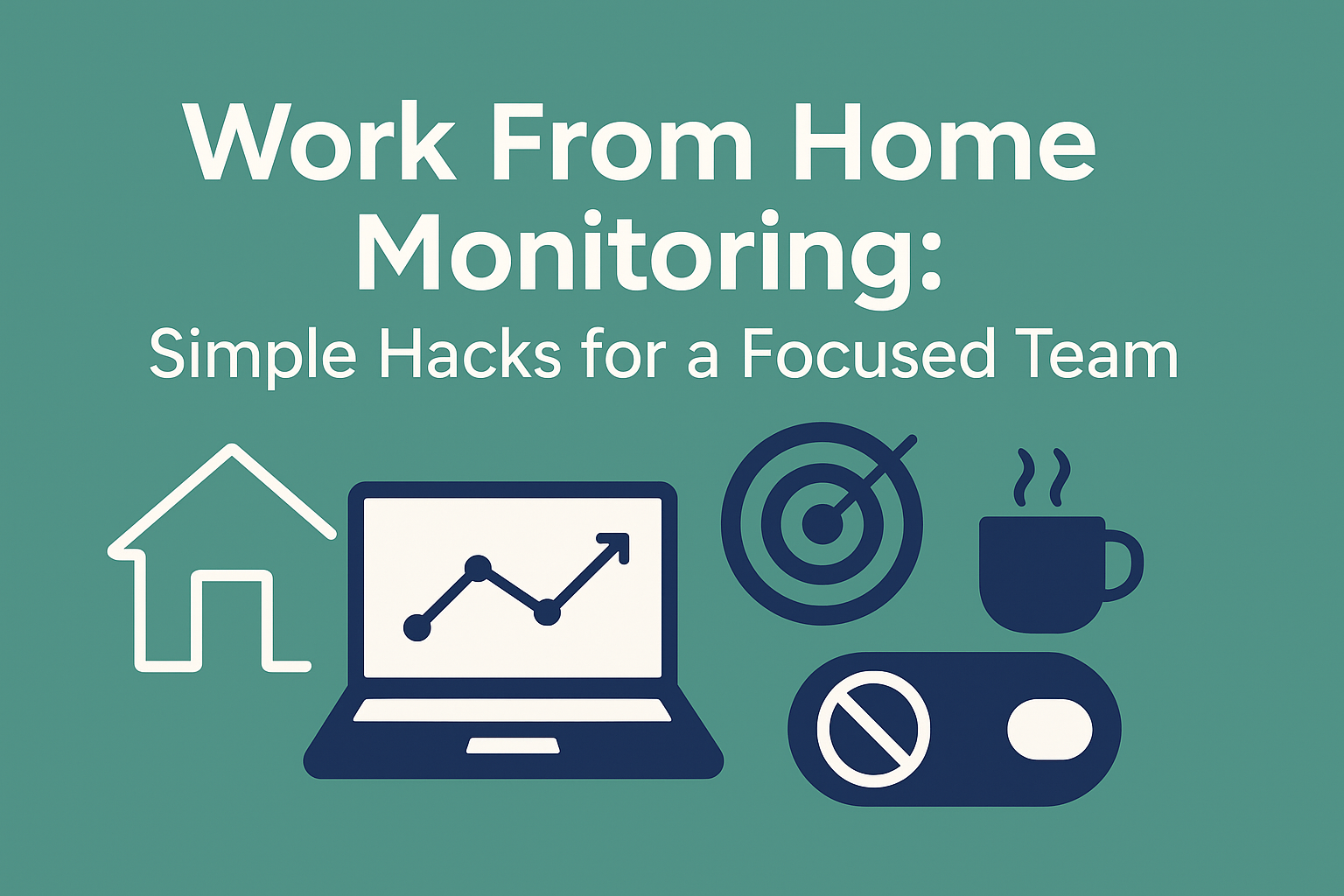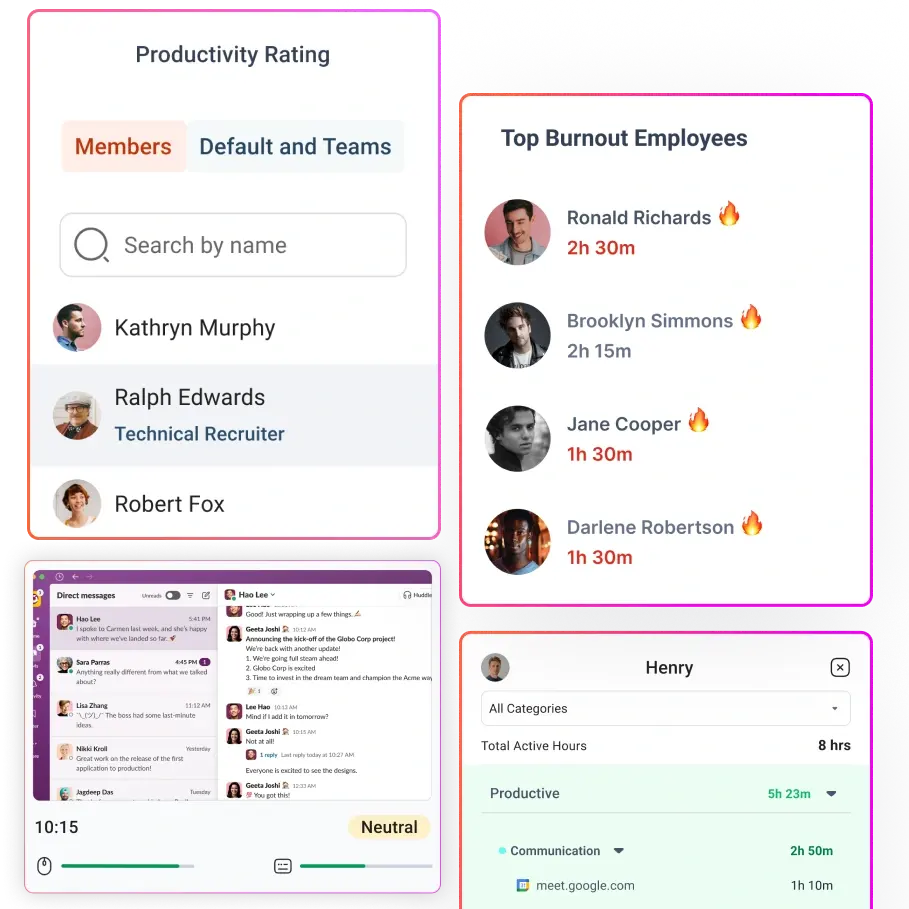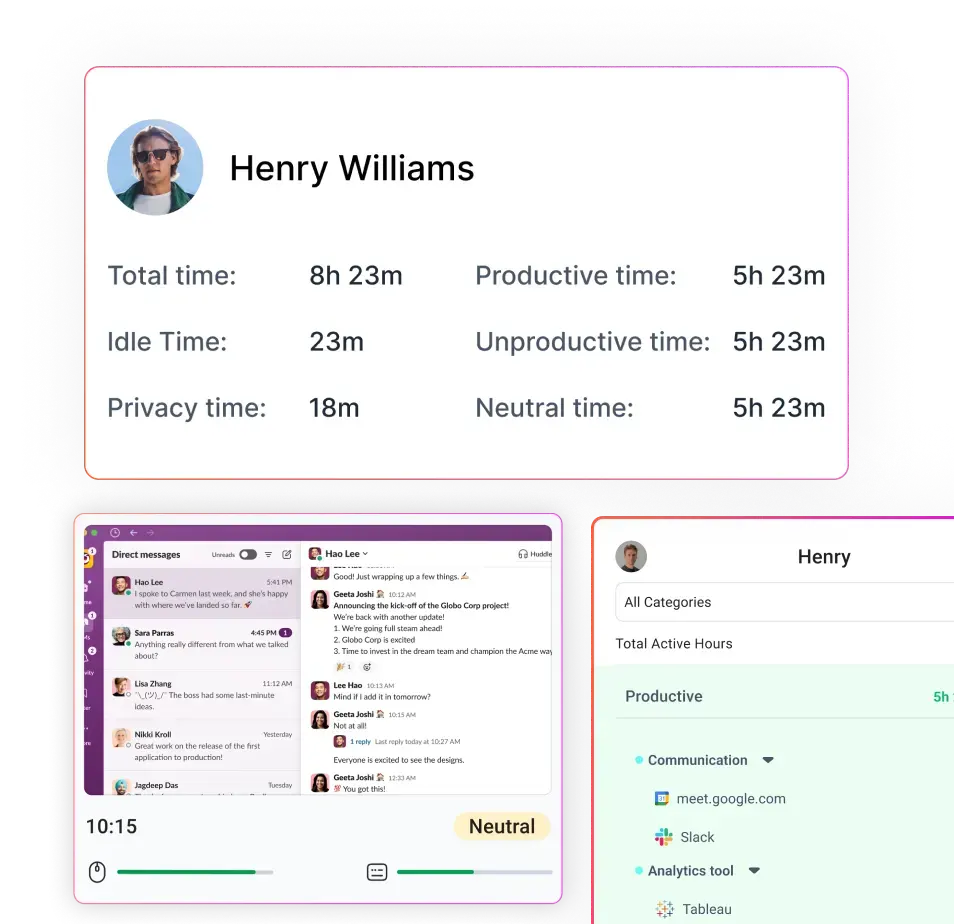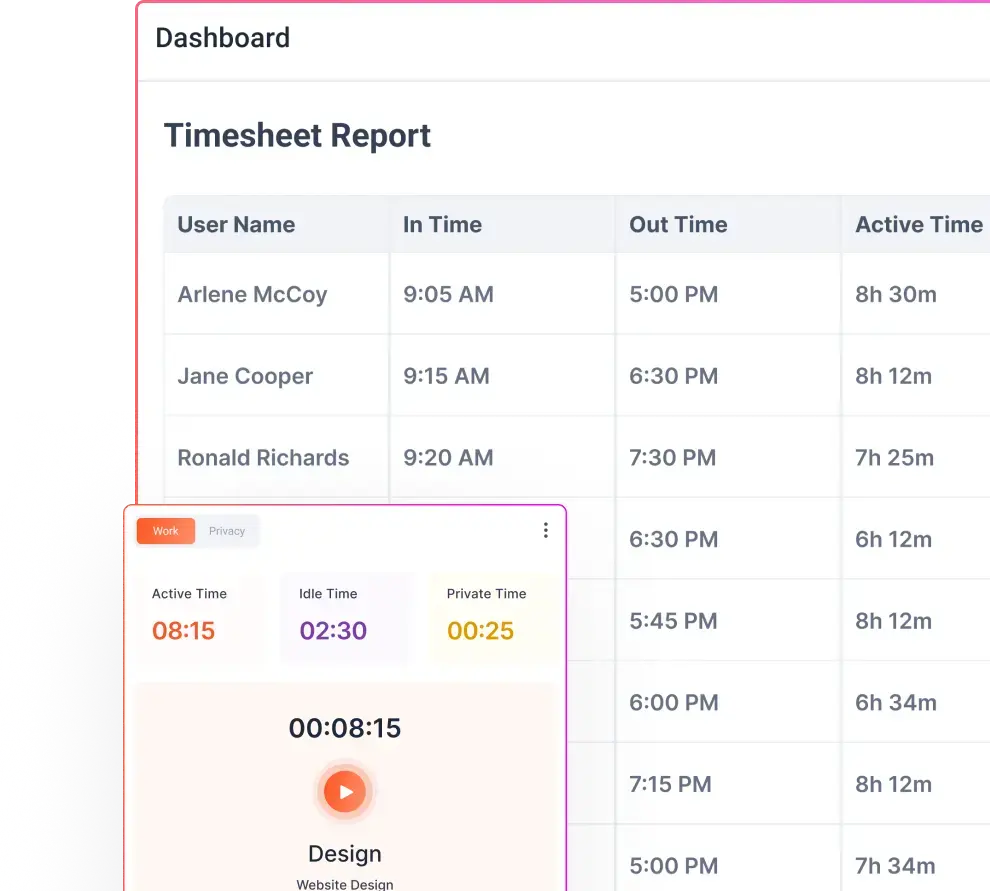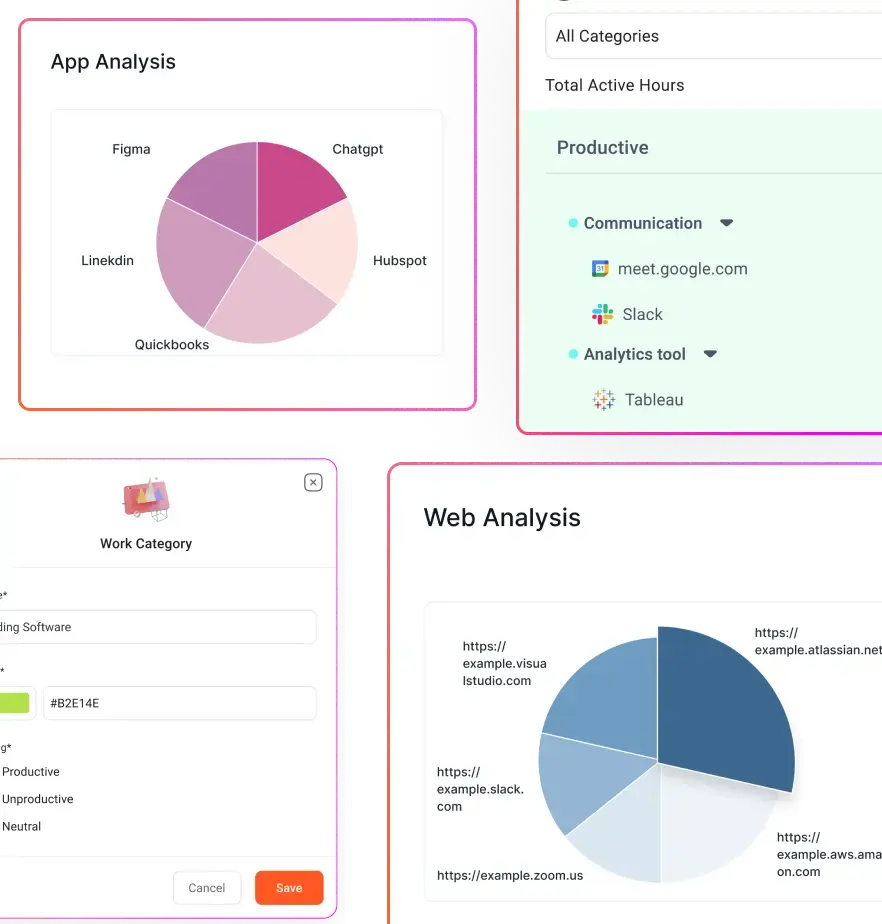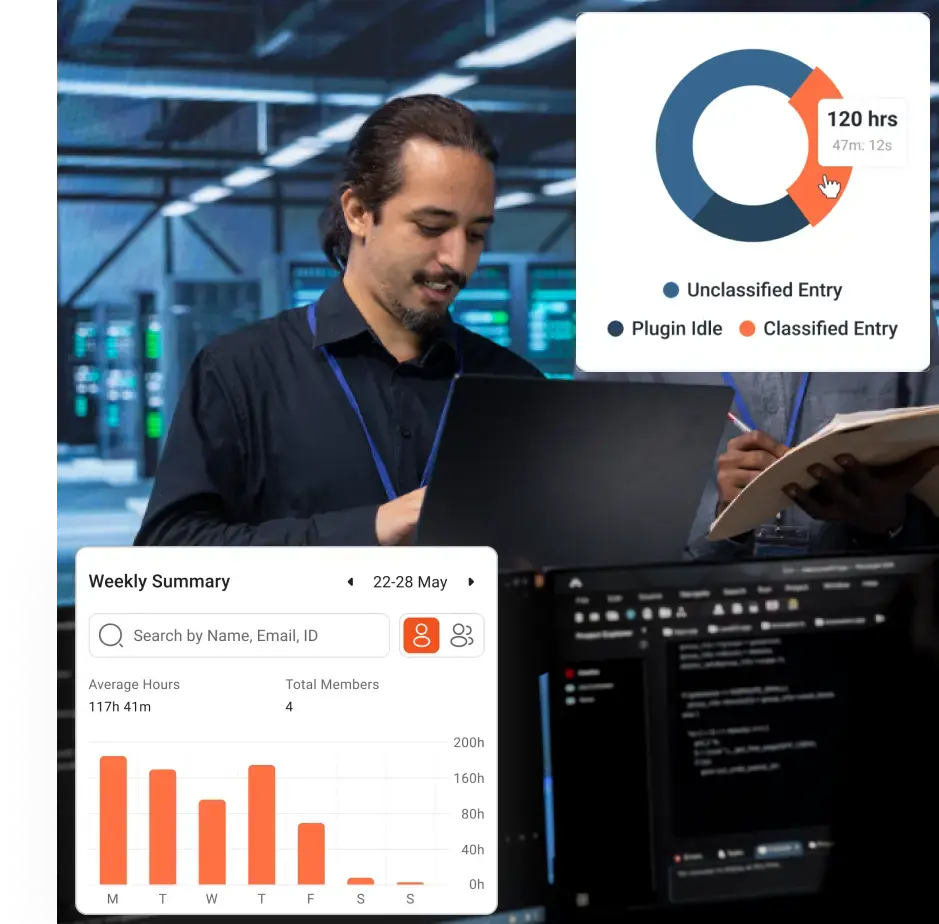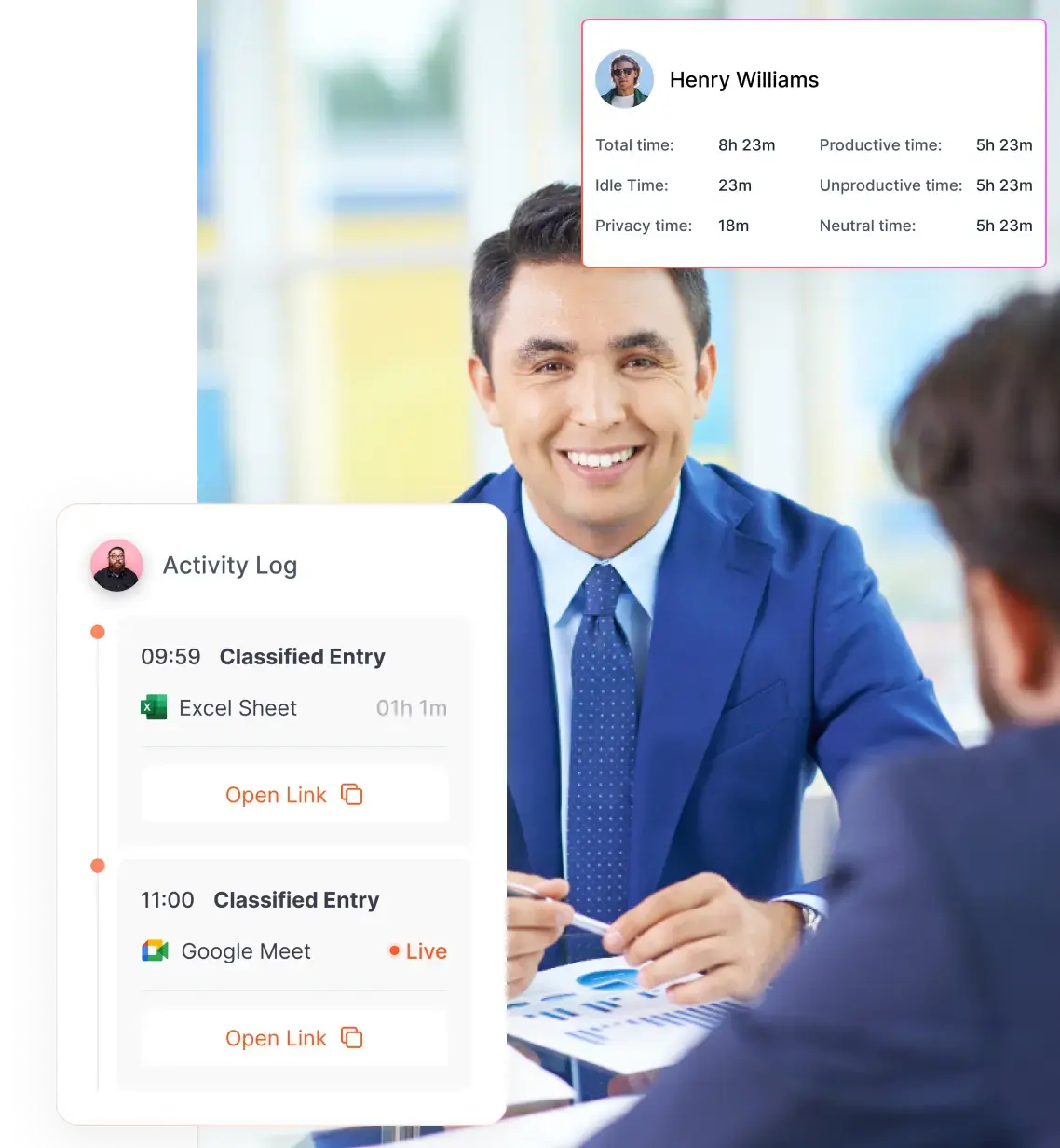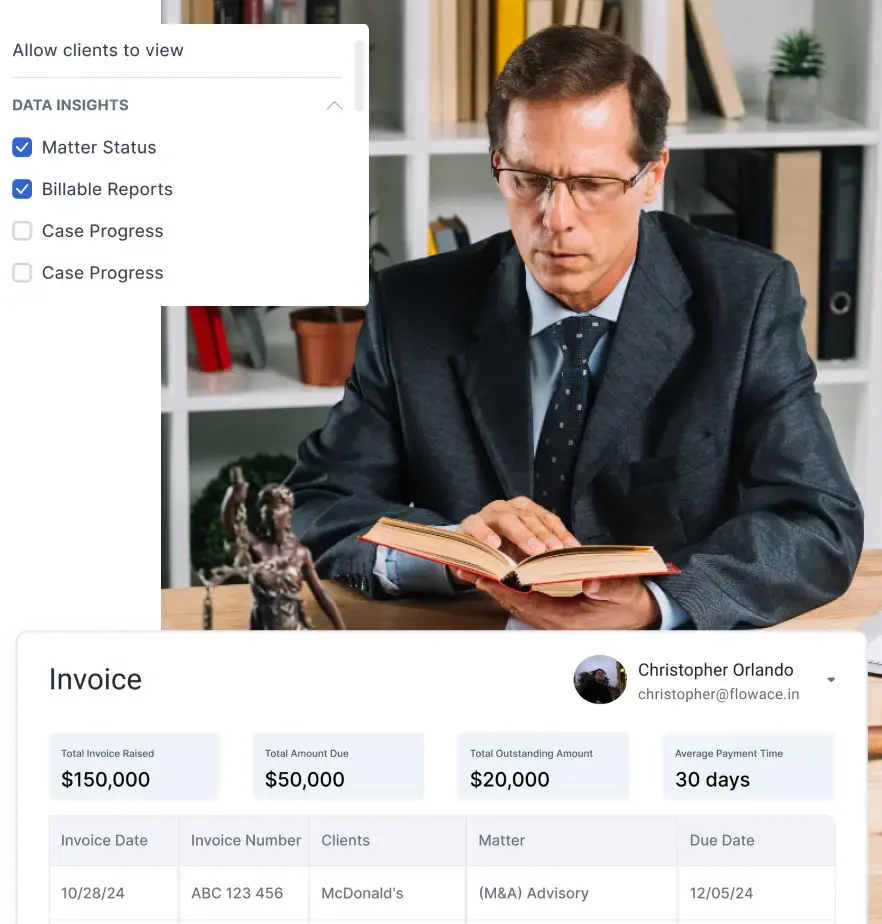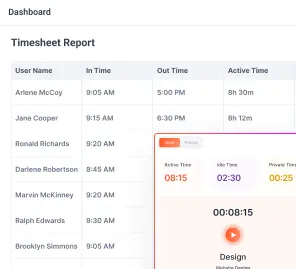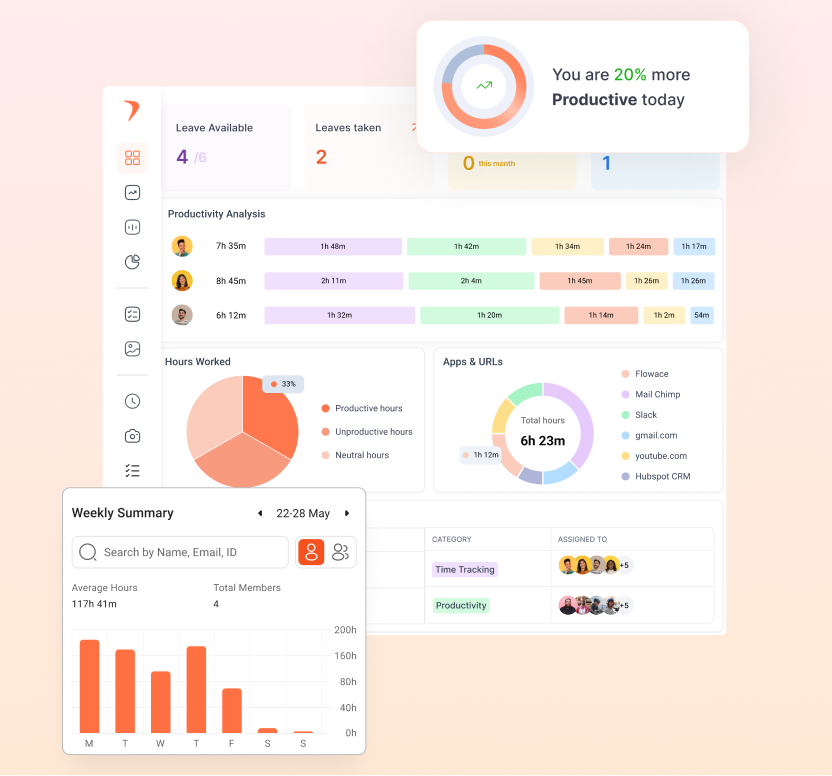You get a clear log of exactly when computers start, shut down, and when breaks happen. Alerts nudge you if someone misses their expected login time. This means you don’t need manual clock-ins. With automatic time tracking and employee monitoring features in place, you can also ensure that productivity and compliance are maintained throughout the workday.
Key Takeaways:
- Watch for early warning signs. Keep an eye on patterns like frequent absences, missed deadlines, low output, poor quality, silence in meetings, long idle stretches, slow replies, and vague updates.
- Use hard data to confirm suspicions. Review attendance logs, task boards, quality metrics, active vs. idle time, response times, meeting participation, and peer/client feedback before you confront anyone.
- Balance empathy with accountability. Set clear expectations, address burnout early, coach underperformers, reinforce healthy work-life boundaries, and use transparent analytics to guide conversations.
- Build a strong remote culture. Live your values, protect work-life balance, foster real connection, and invest in learning and development to keep everyone engaged and self-motivated.
- Leverage the right tools. Flowace automates time tracking, delivers real-time productivity insights, monitors work-life balance, sends inactivity alerts, and fuels transparent, data-driven discussions.
- Roll out monitoring thoughtfully. Start with a small trial, be open with your team, mix data with regular check-ins, tweak settings based on feedback, and celebrate improvements along the way.
- Keep iterating. Monitoring isn’t a one-and-done task. Adjust your approach to maintain trust, drive performance improvements, and ensure your remote team stays productive and connected.
Introduction
If you are managing a remote team, you know it has its perks and perils. You also know that maintaining high work from home productivity isn’t always easy. Almost 85% of managers say hybrid or remote work makes it hard to trust that people are actually productive.
What will you do if one of your usually reliable teammates has gone quiet in meetings and is missing deadlines? What you do next could pull them back on track or let their performance slide further.
To improve employee performance, you should recognize the subtle signs of disengagement at work. As a manager, you should know how to spot those red flags early and ways to address the issue with both empathy and accountability.
Warning Signs a Remote Employee Is Not Working
It’s important to distinguish between an employee having a temporary off-day and one who consistently isn’t working as expected. Here are some common behavioral and performance-related warning signs that a remote employee may be slacking or disengaged:
- Frequent absenteeism or tardiness: Before we dive in, remember that occasional slip-ups happen. We’re looking for patterns that point to real employee performance issues. You see them missing start times, logging off early, or taking unapproved days off. A pattern of “ghosting” during work hours usually means low motivation. A classic red flags in remote work accountability.
- Missed deadlines and low output: One slip-up happens to everyone, but repeated mistakes tell a different story. If their to-do list never shrinks and projects fall behind, your remote employees are not working.
- Reduced quality of work: When they do finish tasks, the results look messy or below your standards. The deliverables need extra revisions or QA flags too many errors. This is an easy sign that shows your employees are not engaged.
- Lack of engagement or communication: They go quiet in meetings, skip optional calls, or keep their camera off. Minimal chat or silence in discussions means they’re mentally “clocked out.”
- Long periods of inactivity: Status indicators or time-tracking show long idle stretches beyond normal breaks. If they’re “offline” during core hours, your remote employees are probably not working.
- Slow response times: A normally prompt teammate who starts dragging their feet is a red flag that they’re not at their desk or not paying attention.
- Avoiding accountability: They blame tech issues or give vague updates. If they dodge detailed progress reports, they might not have much work to report.
8 Ways to Tell If a Remote Employee Isn’t Working
You cannot chastise an employee just because your gut tells you an employee isn’t pulling their weight remotely. You need facts to confirm your suspicions.
How to tell if remote employees are working?
Here are eight reliable ways managers can check if a remote team member is actually working:
1. Review attendance and logins.
You start by looking at their clock-in and clock-out times. Do they log in late or disappear early? Lots of unapproved days off or Monday “sick days” can mean they’re checked out. Online attendance tracking gives you hard facts before you even chat. Based on this data, you can create an employee attendance improvement plan to encourage timely logins.
2. Compare assigned tasks vs. completed work.
This comparison is key to measuring true work from home productivity. Dive into your project board. Are their tickets piling up? If tasks stay “in progress” for ages or deadlines slide again and again, they’re probably not working full hours. Use task data to kick off a conversation. Maybe there’s a blocker you don’t know about. Using an employee time tracking tool helps you see how much time actually went into each ticket.
3. Check quality, not just quantity.
Even if they turn things in, is the work any good? Sloppy code or articles loaded with typos tell you they rushed. If deliverables need constant fixes, it’s a red flag. Peer or client feedback can confirm what you see.
4. Watch for missed deadlines.
One late delivery happens. But when “due Friday, done Monday” becomes routine, you’re looking squarely at employee performance issues. Track how often they ask for extensions. If the pattern holds, you’ll need to have a facts-based talk about expectations.
5. Look at active vs. idle time.
Some idle time is normal. People think or take breaks. But if they log only three active hours when others hit six, that’s a warning. Remote employee monitoring software track mouse and keyboard activities to show you how much they’re really at their desk.
6. Track response times.
You send a quick Slack ping at 2 p.m. and hear back at 10 p.m.? That’s a problem. Slow replies to chat or email can drag the whole team down. Notice patterns of “going dark” and reset expectations for timely communication.
7. Notice meeting participation.
Are their camera-off, mic-muted, and silent in every stand-up? A fully engaged person usually has updates or questions. If a once-active participant goes radio-silent, check in one-on-one. It might be burnout, confusion, or something else you can help fix.
8. Get feedback from colleagues and clients
Finally, don’t rely on metrics alone – listen to what others are saying. Your remote employees don’t work in a vacuum; their output, or lack thereof, affects teammates and customers. Solicit feedback to cross-check your observations. For example, ask project collaborators how it’s been working with this person. Do team members report picking up their slack or waiting on them often?
5 Strategies to Handle a Remote Employee Not Working Full-Time
When you discover someone on your remote team isn’t working as they should, you should address the issue with the right mix of firmness and support. Jumping straight to punitive measures can backfire, especially in a distributed team where trust is paramount. Instead, consider these strategies to get a disengaged remote employee back on track:
1. Set and communicate clear expectations.
You start by spelling out what “full-time work” means for your team. Write down expected hours, response times, and weekly output. Talk through these goals in one-on-ones. Regular one-on-ones help maintain remote work productivity by ensuring everyone stays aligned on priorities. For example, agree that messages get replies within two hours and each person completes five tasks a week. When you focus on results instead of keystrokes, everyone knows what they’re being judged on. Keep these points visible in team docs and meetings, so no one can say they didn’t know.
2. Address burnout and disengagement early.
Sometimes, slacking off hides burnout, not laziness. Spotting this early is key to remote work accountability.Watch for signs like late-night logins or endless meetings without breaks. Learning to identify remote employee burnout is your first step to helping them recharge. When you see them, ask how they’re doing. They might feel isolated or swamped. Encourage PTO and real downtime. If needed, adjust their deadlines or workloads. Catching stress early can re-energize them before they mentally check out.
3. Offer coaching and performance support.
Think of yourself as a coach, not an enforcer. Pull up the data: “You finished three tasks this week, but we expect eight.” Ask what’s blocking them. Maybe they need training or clearer priorities. Then set a simple improvement plan with weekly check-ins, pairing with a mentor, or short focus sessions. Document your steps so you can track progress. Often, people step up when they see you believe in their success.
4. Reinforce healthy work-life boundaries.
It may feel odd, but preventing overwork stops underwork. If someone is online at midnight, they’ll burn out and slow down later. So learn how to identify remote employee burnout and intervene early. Establish normal hours yourself, and tell your team it’s OK to log off on time. Encourage breaks and vacations. You can even set “no email after 7 p.m.” rules. A rested person does more quality work in fewer hours. So, protecting the off-hours helps keep people engaged during work hours.
5. Use analytics with transparency.
Data can guide your conversations. Show your team what the tools track and why. If someone sees they’re averaging three active hours while peers hit six, it can spark an “aha” moment. Share team-wide trends first so no one feels singled out. This is the cornerstone of ethical monitoring remote employees. Then, when needed, discuss individual stats with empathy: “I noticed long idle stretches. What’s happening there?” By being open about data and your intent, you build trust and drive real improvements.
Build a Culture That Prevents Remote Employees from Slacking Off
Culture is the ultimate preventative medicine. A strong remote work culture will naturally discourage employees from slacking because it keeps them engaged and accountable. To build a strong work culture you should focus on a few things:
Communicate your company values consistently
In an office, culture can be absorbed by osmosis. Remotely, you have to be much more intentional. Reiterate your company’s values and mission frequently in the virtual environment. For example, if one core value is “ownership,” celebrate examples of remote team members demonstrating accountability. If “transparency” is a value, practice it in management decisions and encourage open communication. When employees feel connected to a bigger purpose and see leadership walking the talk, they’re less likely to loaf around
Protect work-life balance
A company that promotes work-life balance will have more energized, loyal employees who want to work hard during their hours. Culturally, this means encouraging time off, respecting personal time, and destigmatizing taking breaks. In a positive remote work culture, managers don’t congratulate people for pulling all-nighters – instead they might gently remind someone to disconnect if they notice them online late repeatedly.
Foster real connection with a collaborative, inclusive environment
Virtual teams has its advantages. But it also has challenges. Remote workers can sometimes feel isolated, which can lead to disconnection and low effort. Combat this by actively fostering collaboration and inclusion in your remote team. Use video calls, chat channels, and collaborative tools to make sure everyone’s voice is heard. For example, have regular team brainstorming sessions or virtual coffee chats that build camaraderie. Encourage cross-team projects or buddy systems so no one works siloed for too long. An inclusive environment means every team member feels valued and part of the group, regardless of their work location.
Invest in learning and development
Boredom and stagnation are enemies of engagement. If a remote employee feels there’s no growth or they’re doing the same tedious tasks endlessly, they might disengage and start slacking. Invest in your team’s learning and development to keep them motivated. This can mean providing access to online courses, workshops, virtual conferences, or even a stipend for personal development. Show that you care about their career progression: set development goals, provide mentorship, and promote from within when possible. In fact, 70% of workers say that learning new skills improves their sense of connection to the company. When employees are learning new skills and see a path forward, they stay mentally stimulated and more connected to their work.
How Flowace Helps When a Remote Employee Is Not Working
Even with great management and culture, you can’t manage what you don’t measure. Flowace is a tech solution designed to give managers visibility into remote employee productivity and well-being in an ethical, automated way. It’s an all-in-one platform for time tracking, employee monitoring, and productivity analytics that can directly address many challenges we’ve discussed.
Automated time tracking
Real-time productivity insights
With advanced employee time tracking tools, you see which apps and websites are marked ‘productive’ or ‘unproductive’ in real time.A live dashboard shows task progress and how often someone switches contexts. You’ll spot immediately if a developer isn’t in their IDE or if a teammate is spending too much time on non-work sites.
Work-life balance monitoring
The tool flags late-night work sessions and marathon days that could lead to burnout. It tracks active versus idle time to highlight both overwork and underwork. Spotting these patterns early lets you step in with empathy and help your team maintain a healthy rhythm.
Inactivity alerts & behavioral trends
You can set rules that ping employees after long idle periods, so no one slips through the cracks. AI-powered reports track weekly focus levels and productivity trends over time. Custom alerts like “notifying you if focus dips below 50% for three days” keep everyone accountable.
Transparent, data-driven discussions
You share the same objective logs and trend reports with your team, so performance talks aren’t surprises. Everyone sees the facts, which builds trust and reduces defensiveness. This transparent approach also encourages self-correction and continuous improvement.
No Extra Cost for Replacing Users
With Flowace, it is easy toreplace a team member who leaves with a new hire at no additional cost. Flowace allows seamless user replacement, making it budget-friendly and hassle-free for growing or shifting teams.
Next Steps to Get Started with Monitoring Remote Employees
If you’re ready to tackle remote work accountability head-on, here are some practical next steps:
Try a monitoring tool yourself
Sign up for a free trial. Flowace gives you seven days with every feature unlocked. Use it on a small team or just the one person you’re curious about. Watch the data roll in. Did it match what you expected? Play with alerts, productive-time settings, and reports. After a week, decide which metrics really help you.
Be open with your team
Before you flip the switch everywhere, explain why you’re doing this. Explain to your employees that it’s about fairness, not spying. Tell them exactly what you’ll track and what you won’t. Create an ethical employee monitoring company policy and get everyone’s OK. Transparency builds trust. Transparent data discussions give employees insight into their own remote work productivity and help them self-correct.
Mix data with real conversations
Don’t let the software drive the show. Set up weekly check-ins to review dashboards together. Ask, “Does this look right to you?” Use the numbers to guide your questions: “I saw a lot of idle time on Wednesday—anything up?” Offer help or praise based on what you see. Keep it two-way and invite feedback on the process itself.
Tweak as you go
Monitoring isn’t “set it and forget it.” Watch how people react and how productivity shifts. If screenshots feel too intrusive, turn them off. If certain alerts cause stress, adjust or remove them. Blend the tool into your existing performance routine—goal-setting, peer reviews, manager check-ins—so it complements, not replaces, real human judgment.
Build on your wins
As you refine the setup, celebrate successes. Highlight when someone’s focus time goes up or deadlines start hitting. Use those wins to reinforce why you chose to monitor in the first place. Over time, you’ll find the right balance of insight, accountability, and trust—so your remote team runs smoothly and everyone knows what’s expected.
Final Thoughts
Managing a remote employee, especially in a remote team, can be very frustrating. But with open communication and a smart tool like Flowace, you can get things back on track. Remote work is here to stay, and with the right mix of empathy, accountability, and real-time insights, “out of sight” doesn’t have to mean “out of work.”
Ready to see how it all comes together? Book a free demo with Flowace and discover a simpler way to keep your team engaged, productive, and connected.

